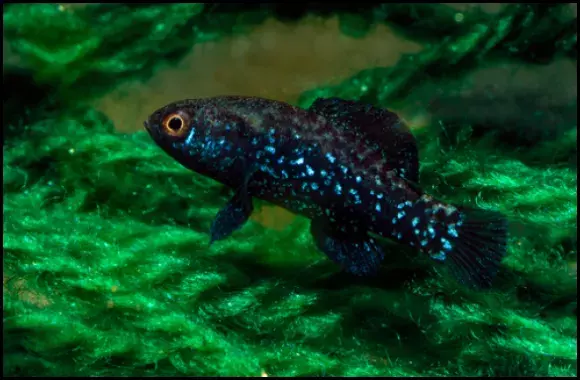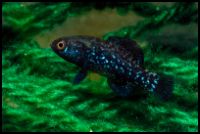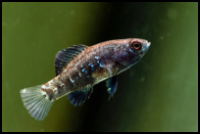


Quick Care Details (Table)
| Livestock Characteristics | Value |
|---|---|
| Care Level | Easy |
| Temperament | Peaceful |
| Diet | Carnivore |
| Maximum Size | 2 Inches |
| Minimum Tank Size | 5 Gallons |
| Plant Safe | Yes |
| Temperature Range | 68-78F |
| PH Range | 6.0-7.5 |
| KH Range | 4-8 Degrees |
| GH Range | 6-12 Degrees |
Species Specific Categories
Helpful Video
Care Details
Aquascape
- Create a natural-looking aquascape with plenty of plants, driftwood, and rocks.
- Use live plants to provide hiding spots and reduce stress for these Sunfish.
- A well-planted tank mimics their natural habitat and encourages natural behavior.
Substrate
- Choose a fine-grained substrate like sand or small gravel to mimic their native environment.
- A soft substrate helps prevent injury to their delicate barbels while foraging.
Disease Prevention
- Quarantine any new fish before adding them to the main tank to prevent introducing diseases.
- Maintain excellent freshwater quality through regular water changes and proper filtration.
- Avoid overfeeding, as excess food can lead to water quality issues and stress the fish.
Filtration
- Use a gentle and efficient filtration system to maintain good freshwater quality.
- A sponge or pre-filter on the intake can protect fry and small fish from being sucked into the filter.
Lighting
- Provide moderate lighting to support plant growth and create a natural day-night cycle.
- Avoid intense lighting, as these Sunfish prefer dimly lit environments.
Water Flow
- Pygmy fish prefer slow to moderate water flow in the tank.
- Use filter outlets or powerheads to create gentle circulation without causing too much stress.
Hardiness
- These Sunfish are generally hardy, but maintaining stable water parameters is essential.
- Avoid sudden fluctuations in temperature, pH, and water hardness to prevent stress and health issues.
Temperament and Behavior
Aggression
- Aggression is typically not a concern with Pygmy Sunfish.
- They are not territorial and are generally compatible with other peaceful fish.
Breeding
- Breeding Pygmy fish can be challenging due to their small size and specific requirements.
- Provide plenty of hiding spots and dense vegetation for the female to lay eggs.
- The male will guard the eggs and fry, but it's essential to keep an eye on the tank to prevent potential predation.
Compatibility
- Pygmy fish are best kept in a species-specific setup or with other small, peaceful fish.
- Avoid keeping them with larger or more aggressive species that may outcompete or prey on them.
- They can be suitable tankmates for small, non-aggressive community fish.
Activity Level
- Pygmy fish are generally active during the day but may exhibit some nocturnal behavior.
- They are exploratory and enjoy swimming around the middle and bottom levels of the tank.
Clean up Crew
- Pygmy Sunfish are not effective clean-up crew members like some other aquarium species.
- They are primarily carnivorous and won't actively consume algae or leftover food.
- A separate clean-up crew consisting of snails or shrimp may be necessary for maintaining the tank's cleanliness.
Diet and Nutrition
Dry Foods
- Sometimes High-Quality Flake or Pellet Foods will be accepted and offer a variety of high-quality flake or pellet foods specifically formulated for small tropical fish. Look for products that contain a balanced mix of proteins, vitamins, and minerals.
- Your Pygmy Sunfish may not take flakes right away. You might need to train them to understand that it is food. These fish in nature are micro predators and are used to eating microfauna in the wild.
- Look for options specifically designed for small fish or omnivorous species.
- Ensure the food is fresh and not expired to maintain nutritional value.
Frozen Foods
- Offer frozen foods like daphnia, brine shrimp, and bloodworms as a treat.
- Frozen foods are an excellent source of protein and can add variety to the diet.
Live Foods
- Pygmy Sunfish thrive on live foods such as small insects, mosquito larvae, and small crustaceans.
- Live foods mimic their natural diet and can be a nutritious addition to their meals.
Vegetables
- Some Pygmy Sunfish species may nibble on blanched vegetables like zucchini or spinach.
- They generally will not eat vegetables.
Algae
- Sunfish will generally not eat algae.
Feeding Schedule
- Feed small amounts multiple times a day rather than a large meal at once.
- Aim for 2 to 3 feedings per day, ensuring they consume the food within 1-2 minutes.
- Mix up the diet by rotating between dry foods, frozen foods, and occasional live foods.
- Supplement with vegetables or algae if the fish show interest.
- Monitor their feeding behavior and adjust the schedule as needed based on their appetite.
Tank Parameters
Tank Size
- Recommended minimum tank size: 10 gallons for a single pair or trio of Pygmy Sunfish.
- A larger tank is preferable for a community setup with other fish.
Tank Length and Measurements
- Minimum tank length: 20 inches (for a 10-gallon tank) to provide enough swimming space.
- Provide hiding spots and plants for enrichment, but avoid overcrowding the tank.
The Species Maximum Size
- Pygmy Sunfish generally reach a maximum size of around 1.5 to 2 inches (3.8 to 5 cm).
- They are small fish and suitable for nano or small aquarium setups.
Water Temperature
- Ideal water temperature range: 70°F to 78°F (21°C to 26°C).
- Keeping the temperature stable within this range is crucial for their well-being.
pH (Acidity/Alkalinity)
- Recommended pH range: 6.5 to 7.5.
- Pygmy Sunfish prefer slightly acidic to slightly alkaline freshwater conditions.
KH (Carbonate Hardness)
- Recommended KH range: 2 to 6 dKH (36 to 107 ppm).
- Maintaining a stable carbonate hardness helps buffer pH fluctuations.
GH (General Hardness)
- Recommended GH range: 4 to 8 dGH (71 to 143 ppm).
- Pygmy fish thrive in moderately hard freshwater conditions.
Nitrate (NO3) Levels
- Recommended nitrate levels: Below 20 ppm (parts per million).
- Regular water changes and efficient filtration help control nitrate levels.
History, Popularity, History and Species Variety Details
Pygmy Sunfish’s Natural Habitat
Pygmy Sunfish, belonging to the Elassoma genus, are native to freshwater habitats in the southeastern United States. Their distribution extends across several states, including but not limited to Florida, Georgia, Alabama, Mississippi, Louisiana, and South Carolina. Pygmy inhabit various types of freshwater environments, including streams, rivers, ponds, swamps, and backwaters of larger bodies of water. They can be found in both densely vegetated areas and open-water habitats. Pygmy Sunfish are often associated with aquatic vegetation, such as submerged plants, floating plants, and emergent vegetation. They seek shelter and breeding sites among the vegetation, which provides cover and protection from predators. Pygmy Sunfish are adaptable to a range of water conditions within their native habitats. They can be found in both clear and slightly murky waters. The water temperature typically ranges from 68°F to 78°F (20°C to 26°C), but specific fish may have preferences within this range. Their habitats consist of a variety of substrates, including sand, gravel, mud, and leaf litter. Pygmy Sunfish are known to utilize natural structures such as fallen logs, roots, and submerged branches as hiding places and for territorial displays. Within their broader habitat, Pygmy Sunfish may occupy specific microhabitats that meet their specific needs. These microhabitats can include areas with dense vegetation, shallow waters near the water's edge, or locations with submerged leaf litter or woody debris. Pygmy fish are adapted to deal with seasonal changes in their native habitats. They may experience fluctuations in water levels, temperature, and food availability throughout the year. Some species can tolerate brackish water conditions in certain coastal habitats. Pygmy Sunfish play a vital role in their natural ecosystems. They occupy various trophic levels and contribute to the food web dynamics within their habitats. As small predators, they help control populations of small invertebrates, such as insects and crustaceans. Understanding the natural habitat of Pygmy Sunfish can help aquarists replicate similar conditions in their tanks, providing a more enriching and suitable environment for these fish. It's important to mimic key elements such as vegetation, water parameters, and suitable tank decor to ensure their well-being and promote natural behaviors.
Different Types of Pygmy Sunfish
-
Elassoma evergladei (Everglades Pygmy Sunfish):
- Origin: Everglades Pygmy native to the Everglades region of Florida, USA.
- Size: Everglades Pygmy typically reaches around 1 inch (2.5 cm) in length.
- Coloration: Males exhibit bright orange or red coloration, while females have more subdued colors.
- Habitat: Everglades Pygmy found in slow-moving or stagnant freshwaters, including marshes, swamps, and ditches.
- Special Features: Males build nests and guard the eggs until they hatch.
-
Elassoma gilberti (Dwarf Pygmy Sunfish):
- Origin: Elassoma gilberti native to the southeastern United States, including parts of Alabama, Georgia, and Florida.
- Size: Typically grows to about 1.5 inches (3.8 cm) in length.
- Coloration: Males display a stunning combination of iridescent blues and greens, while females are generally lighter in color.
- Habitat: Found in shallow, vegetated bodies of water such as ponds, ditches, and swamps.
- Special Features: Males build nests and display courtship behaviors by flaring their fins.
-
Elassoma okefenokee (Okefenokee Pygmy Sunfish):
- Origin: Native to the Okefenokee Swamp region of Georgia and Florida, USA.
- Size: Typically reaches around 1.5 inches (3.8 cm) in length.
- Coloration: Males exhibit vibrant red or orange coloration with vertical stripes, while females have more muted colors.
- Habitat: Found in the blackwater habitats of swamps, marshes, and slow-moving streams.
- Special Features: Males build nests and engage in courtship displays to attract females.
-
Elassoma zonatum (Banded Pygmy Sunfish):
- Origin: Native to various southeastern states, including Texas, Louisiana, Mississippi, and Alabama.
- Size: Typically grows to about 1.5 inches (3.8 cm) in length.
- Coloration: Males feature striking vertical bars or bands on their bodies, while females have more subdued coloration.
- Habitat: Found in a variety of freshwater habitats, including rivers, streams, and swamps.
- Special Features: Males build nests and exhibit territorial behaviors during breeding.
Breeding Pygmy Sunfish
- Species Selection: Determine the specific species of Pygmy Sunfish you want to breed. Each species may have slightly different breeding requirements, so research the particular species you plan to breed.
- Tank Setup: Prepare a breeding tank, which can be a smaller tank or a partitioned section within a larger tank. Provide suitable water conditions, including a temperature between 70°F and 78°F (21°C and 26°C) and a pH range of 6.0 to 7.5. Include aquatic plants, driftwood, and other hiding places to create a natural environment.
- Conditioning the Fish: Separate a male and female pair into the breeding tank. Condition them by feeding a varied and nutritious diet, including live or frozen foods, to enhance their reproductive health.
- Courtship and Spawning Behavior: Observe the fish for courtship behaviors, such as the male displaying vibrant colors, flaring fins, or performing zigzag dances to attract the female's attention. The male may build a small nest or clearing in the substrate using his mouth.
- Spawning: When the female is receptive, the male will lead her to the nest and begin a spiraling courtship dance. The female will deposit eggs, and the male will fertilize them externally. The process may be rapid, lasting only a few seconds.
- Removing the Adults: After spawning, it's essential to remove the adults from the breeding tank to prevent them from eating the eggs or disturbing the nest. Place them back into their regular tank or separate holding tanks.
- Incubation and Hatching: The male will guard the eggs until they hatch, which typically occurs within a week or two, depending on the species and temperature. The eggs are adhesive and will stick to the substrate or nearby surfaces.
- Fry Care: Once the fry hatch, they will initially attach themselves to the substrate or hide among vegetation. Feed them small live foods, such as newly hatched brine shrimp or microworms, to ensure their nutritional needs are met. Perform regular water changes to maintain good water quality.
- Growth and Separation: As the fry grow, you may need to separate them to prevent overcrowding and competition for resources. Gradually transition them to finely crushed dry foods, such as high-quality fry flakes or micro-pellets, as they grow.
- Patience and Observation: Breeding Pygmy Sunfish can be a challenging and time-consuming process. Patience is key, as successful spawns may not occur immediately. Observe the fish closely, make necessary adjustments, and adapt your approach based on their behavior and needs.
Male gender vs Female gender (Sexual Dimorphism)
- Size and Shape: In some species, males tend to be slightly larger and have a more elongated body shape compared to females. However, this difference may not be significant in all species, so additional indicators are necessary.
- Coloration and Markings: Males often display more vibrant and intense colors compared to females. They may exhibit brighter hues, distinct patterns, or more prominent markings. Females, on the other hand, may have more subdued colors or lack certain coloration found in males.
- Fin Characteristics: Males typically have longer, more elaborate fins compared to females. Look for exaggerated fin extensions, such as elongated dorsal fins or longer tail fins, which are more pronounced in males. Females may have shorter, more rounded fins.
- Behavior and Courtship: During courtship, males may display territorial behaviors, such as chasing or flaring their fins to attract females. Observing these courtship rituals can help identify the males in a group.
- Vent Location: In some species, males may have a vent located closer to the anal fin, while females have a vent positioned closer to the tail. This difference may be more evident during the breeding season.
Frequently Asked Questions
Are Pygmy Sunfish suitable for small aquariums?
Yes, Pygmy Sunfish are excellent choices for small aquariums due to their small size and relatively low space requirements. A tank as small as 10 gallons can accommodate a small group of Pygmy Sunfish. If you want to keep only a single Pygmy Sunfish you can keep it in a 5 gallon aquarium.
Can Pygmy Sunfish be kept with other fish?
Pygmy Sunfish are generally peaceful and can be kept with other small, non-aggressive fish. However, it's important to consider compatible tank mates that share similar water parameters and peaceful temperament to ensure harmonious coexistence.
Do Pygmy Sunfish require live foods for their diet?
While Pygmy Sunfish appreciate live foods, they can be trained to accept high-quality flake or pellet foods as their primary diet. However, offering occasional live or frozen foods, such as brine shrimp or daphnia, can provide additional nutritional enrichment and mimic their natural feeding behavior.
Do Pygmy Sunfish jump out of the aquarium?
Pygmy Sunfish have been known to jump, especially when startled or stressed. To prevent accidental escapes, it's crucial to have a secure tank cover or lid in place to ensure the fish remain safely in the aquarium.
Can Pygmy Sunfish be bred in home aquariums?
Yes, Pygmy Sunfish can be bred in home aquariums with proper setup and conditions. However, breeding Pygmy Sunfish may require specific environmental cues, such as temperature changes or the presence of suitable nesting sites, depending on the species.
How can I differentiate between male and female Pygmy Sunfish?
Male and female Pygmy Sunfish can have subtle differences in size and coloration. Males may display more vibrant colors, elongated fins, or other distinctive markings. However, identifying the sex of some species may require close observation or expert knowledge.
Do Pygmy Sunfish tolerate brackish water?
While most Pygmy Sunfish are found in freshwater habitats, a few species can tolerate brackish water conditions in certain coastal areas. It's essential to research the specific species you plan to keep to understand their preferred water conditions.
Can Pygmy Sunfish be kept in outdoor ponds?
Some Pygmy Sunfish can adapt to outdoor pond environments if the water conditions, temperature range, and habitat mimic their natural requirements. It's important to consider local climate and potential predators when considering outdoor pond setups. This will not work for northern areas where it is common for water to freeze.
Can Pygmy Sunfish be kept in a community tank?
Pygmy Sunfish can be kept in a community tank with other small, peaceful fish that share similar water parameters and temperament. However, it's important to monitor their interactions and ensure adequate hiding places to prevent aggression or competition for resources.
How long do Pygmy Sunfish live?
The lifespan of Pygmy Sunfish can vary depending on the species and the quality of care provided. On average, they can live for about 2 to 3 years, but with proper care, some individuals may live up to 5 years or more.
Are Pygmy Sunfish suitable for beginners?
While Pygmy Sunfish can be kept by beginners, they require some level of experience and attention to water parameters and tank conditions. Novice aquarists should ensure they are knowledgeable about the specific needs and care requirements of Pygmy Sunfish before keeping them.

